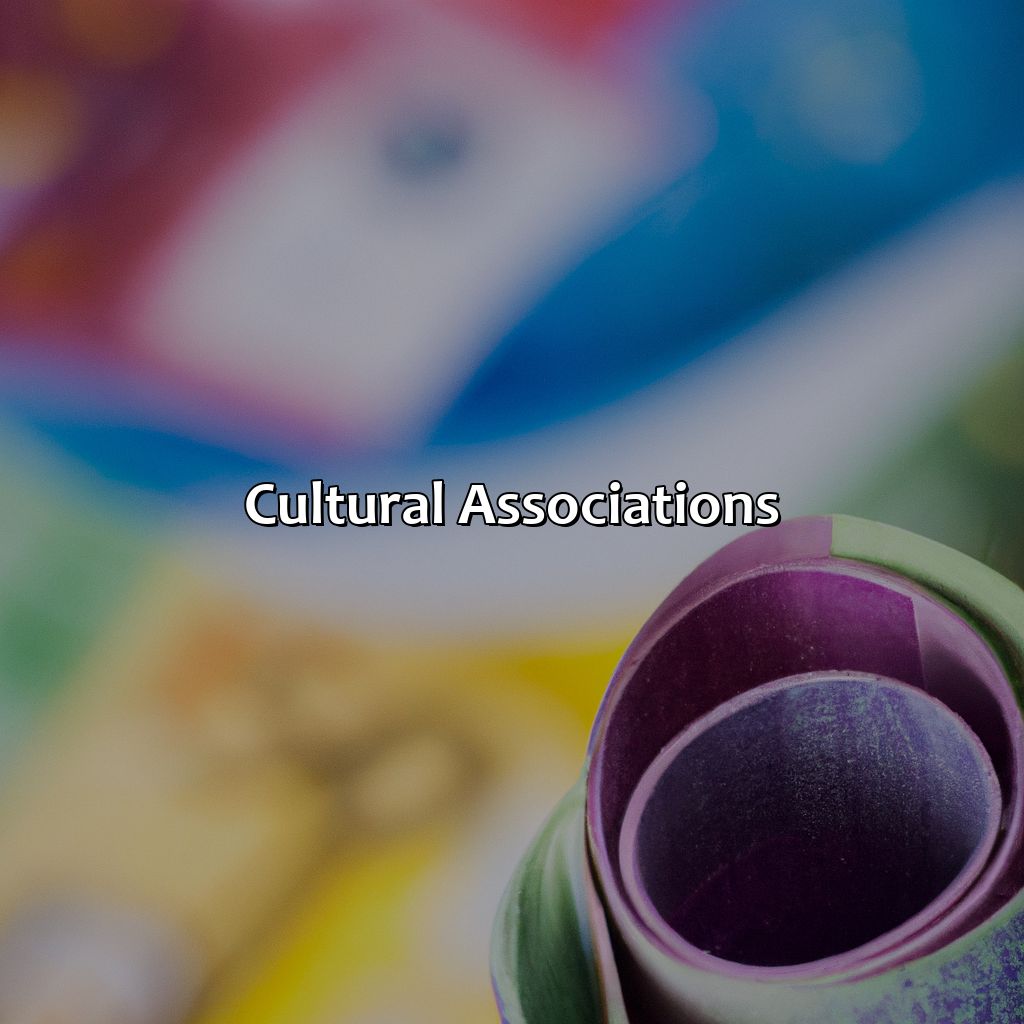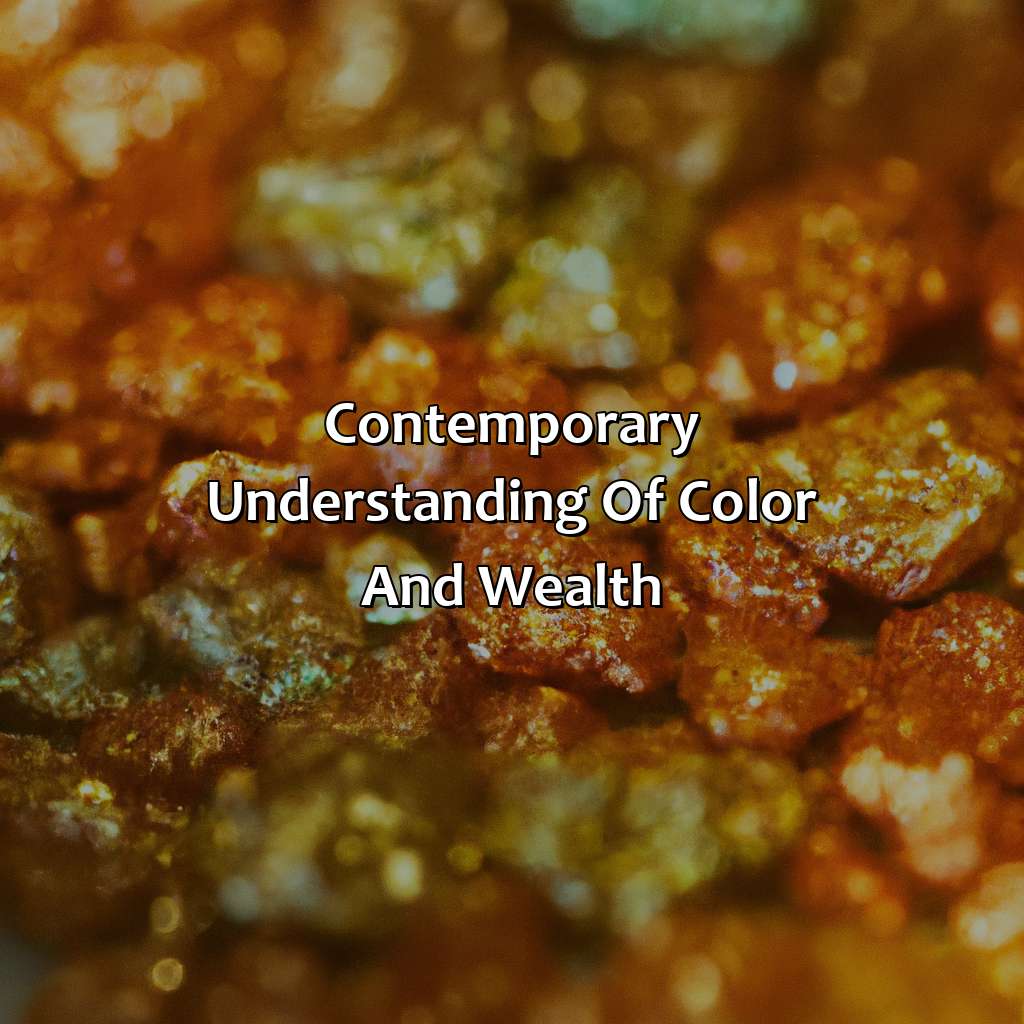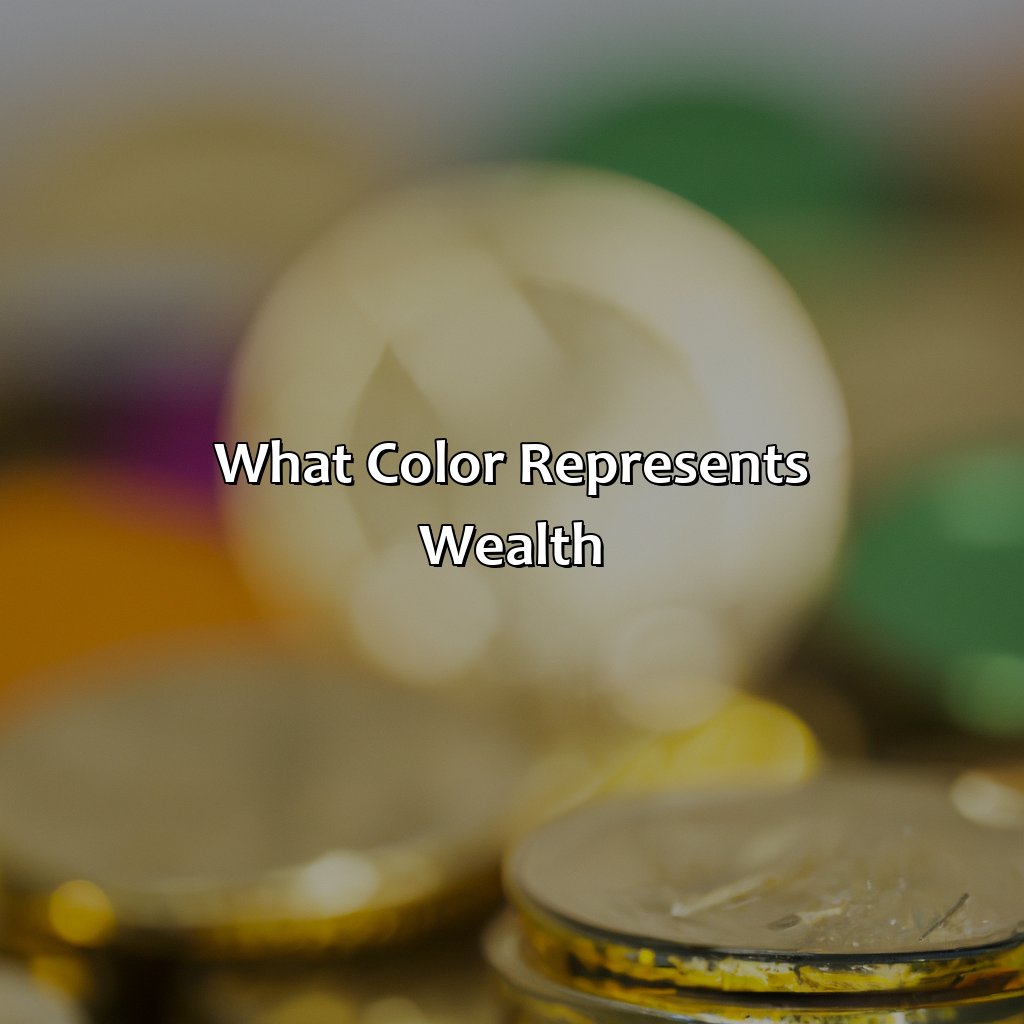Key Takeaway:
- Cultural associations with colors and wealth vary: Different cultures associate different colors with wealth and prosperity, such as red in China, yellow in Japan, gold in India, green in Islamic cultures, and purple in Ancient Rome.
- Psychological associations with colors and wealth also exist: Colors like blue, black, white, and silver are often associated with wealth and prosperity due to their perceived qualities like trustworthiness, sophistication, and modernity.
- Color can be used strategically in branding, marketing, interior design, fashion, and personal finance to represent wealth and attract positive energy: Whether it’s choosing the right color for a logo, painting a room a certain color, or wearing a certain color to important meetings, color can be a powerful tool for representing wealth and influencing mindset.
Cultural Associations

Photo Credits: colorscombo.com by Peter Martin
Are you curious about the cultural significance of colors with prosperity and wealth? Look no further! The “Cultural Associations” section, titled “What Color Represents Wealth,” has the answers. It explores how red is used in China to symbolize wealth, yellow and white in Japan, gold in India for luck, green in Islamic cultures to signify money, and purple in Ancient Rome for luxury and prosperity.
Red – China
The color red holds an auspicious meaning in Chinese culture and is synonymous with good fortune and prosperity. It is the most popular color for weddings, festivals, and New Year celebrations. Red envelopes containing money are also given as gifts to mark these occasions. The concept of red for wealth is deeply ingrained in Chinese society.
Red has been historically associated with the ruling class in China, with emperors and high officials wearing it as a symbol of power and status. It was thought that wearing red clothing or accessories would attract riches and success.
In addition to being a prosperous color, red is also believed to ward off evil spirits and bad luck. It serves as a protective shield against negative energies.
To incorporate the luck and prosperity associated with the color red, businesses can consider using it in their branding or marketing strategies. Red can be used to draw attention to important details such as discounts or promotions. The use of red in interior design and architecture can also create a sense of luxury and opulence. In fashion, accessories such as bags or shoes in shades of red can add an element of elegance to any outfit.
Overall, incorporating the lucky color for money into daily life can attract positive energy and prosperity. Harnessing the power of red for your business or personal life can bring about positive change by attracting wealth and success.
Why settle for just one color representing wealth when Japan has three: gold, white, and purple?
Yellow – Japan
Japan considers yellow as the color for Nobility, courage, and knowledge. The color Yellow has a royal association with the Imperial family and represents nature in Japan.
| Country | Color | Representation |
| Japan | Yellow | Nobility, courage, knowledge, nature, Imperial family Association |
Unique Japanese cultural practices such as Kogei influence their approach to design and architecture. They often use yellow color application in Kimonos, ranging from motifs to backgrounds.
Fun Fact: The Buddhist monk Saigyo mentioned yellow leaves falling near Nikko Tōshō-gū Shrine in his poem collection “Sankashū” in 1198 AD.
India’s love for gold knows no bounds – it’s not just a color, it’s a way of life for wealth and prosperity.
Gold – India
Representing wealth and prosperity, gold is an auspicious color in Indian culture. The significance of the color can be seen in various aspects of daily Indian life.
| Aspect | Explanation |
|---|---|
| Festivals and Celebrations | Gold jewelry is a common gift during weddings, as it is believed to bring good fortune and wealth. |
| Interior Design | Many Indian homes incorporate gold accents and motifs into their decor, such as paintings and statues. |
| Fashion | Gold embroidery or embellishments are commonly used in traditional Indian clothing, symbolizing prosperity and luxury. |
In addition to being a prosperous color, gold is also a lucky color for money. In fact, using golden colored items like chimes or coins are believed to attract financial abundance according to ancient Vastu Shastra principles.
One notable example of the association between gold for wealth in India is the Golden Temple located in Amritsar. This Sikh temple features a stunning exterior made entirely of gold leaf, symbolizing the spiritual richness of the faith.
Incorporating golden hues into your personal or professional life can help create a sense of abundance and success. From incorporating gold accents in your wardrobe or office design to using golden trinkets for good luck, this fortunate shade can bring good fortune wherever it is seen.
Green may be the lucky color for money in Islamic cultures, but let’s face it, money is lucky no matter what color it comes in.
Green – Islamic cultures
The color green holds great significance in Islamic cultures as it is often associated with prosperity, wealth and success. Green is considered an auspicious color that represents growth and renewal of life. In addition, green has strong links to nature and new beginnings, symbolizing a fresh start and a promising future.
In many Islamic communities, green is viewed as a prosperous color that can bring good luck and financial success. It is commonly used in clothing, decoration, and design elements to signify wealth and abundance. The color also has connections to health, balance and harmony, which are highly regarded values in Islam.
Green for money or green for wealth has been an essential aspect in Islamic traditions where people incorporate the use of this prosperous color in daily lives such as houses or even business dealings. The use of this lucky-color for money represents beliefs about approaching actions with a certain mindset that would lead to prosperity.
Pro Tip: When using green in your life or business branding, be mindful of using the right shade of green that aligns with your personal or brand goals for wealth building.
Purple may have been an auspicious color for Ancient Rome, but if you want to prosper in modern times, you might want to go for green or gold.
Purple – Ancient Rome
Purple, an ancient Roman luxury color, signified wealth and nobility. In Rome, only high-ranking officials or members of the royal family could wear purple robes. This color was obtained from a specific species of shellfish native to the Mediterranean sea, making it expensive. It was considered an auspicious color and a symbol of prosperity.
Furthermore, the dyeing process for purple fabric was complex and required multiple steps, including heat treatments and precise timing. The resulting vibrant shade of purple added to its allure and exclusivity as a luxurious color.
Unique details about the significance of purple in ancient Rome include its association with Julius Caesar’s domination over Egypt, which brought access to an abundant supply of royal purple dye from Tyrian snails.
To use purple for wealth in contemporary times, one can incorporate it into branding or interior design schemes for upscale businesses. For instance, by using purple hues in logos or product designs or adding accent pieces like pillows or curtains with a rich purple tone to convey opulence. The use of this prosperous color is found in high-end fashion and accessories too.
Color therapy for wealth? Just pick blue for trustworthiness, black for luxury, white for simplicity, and silver for innovation, and watch your business shine.
Psychological Associations

Photo Credits: colorscombo.com by Mark Allen
To comprehend the psychological links between hue and wealth, you must assign certain colors to individual jobs. When it comes to hue and wealth, success, and abundance, color therapy is important. We’re going to look at four colors that denote wealth and usually appear in business, branding, marketing, advertising, sales, finance, and the economy. These colors are blue, black, white, and silver. Each of them has a unique connection with wealth and prosperity.
Blue – Trustworthiness and stability
Blue is an auspicious color that represents trustworthiness and stability. In various cultures, blue is perceived as the color of calmness and security. This color is also often associated with financial security, indicating reliability and dependability in business dealings.
| Culture | Meaning |
|---|---|
| Western countries | Stability, loyalty, wisdom |
| Middle East | Safety, peace, honesty |
| China | Wealth, prosperity, protection from evil spirits |
| Greece & Rome | Steadfastness and constancy in adversity. |
Blue is a prosperous color that brings good fortune in business ventures. It is often used by banks and financial institutions to convey their trustworthiness to their clients. Moreover, blue has positive effects on psychological well-being—it helps reduce stress and anxiety.
Using blue for wealth can be achieved through color therapy for wealth or incorporating it into your surroundings. Decorating one’s office with shades of blue can induce feelings of tranquility and dependability amongst your colleagues as well.
Incorporating blue into branding can offer a sense of professionalism and genuine care to their customers. Using blue in logos establishes brand identity while promising quality service.
Don’t miss out on the benefits of using blue as an auspicious color for wealth in your personal or professional life. Utilize this prosperous color’s potentials to strengthen bonds with individuals around you!
If black is the color of sophistication and luxury, then why am I still broke?
Black – Sophistication and luxury
Representing wealth and sophistication, black is the go-to color for high-end fashion and accessories due to its timeless elegance. Black signifies power, prestige, and formality, making it an auspicious color in Chinese culture that represents prosperity. It also has a grounding effect and calms the mind, making it one of the most effective colors for color therapy for wealth. In terms of interior design and architecture, black provides depth, contrast and pairs harmoniously with metallics to create a luxurious ambiance.
Pro Tip: When using black for wealth or luxury purposes, pair it with metallic finishes such as silver to add modernity to its classic appeal.
White may represent purity and simplicity, but when it comes to wealth, it’s definitely an auspicious color to incorporate in your life and business.
White – Purity and simplicity
White is widely known as an auspicious color and a symbol of purity, simplicity, and divinity in many cultures. It represents new beginnings, peace, and harmony. Moreover, the color white has been used for centuries to convey a sense of wealth and luxury. In some cultures like India, wearing white during special occasions showcases affluence.
In color therapy for wealth, white is used to enhance clarity and focus. It can also help to calm anxiety and reduce stress levels, two factors that can easily block abundance from flowing into our lives.
To invite more prosperity into your life or business, consider incorporating white into your branding or interior design. White walls create openness in small spaces while simultaneously making a room feel larger. Pairing white with gold accents can also signify luxury and sophistication. Accessorizing with pearls or crystals can bring additional prosperity energy.
Overall, utilizing the prosperous color of white for wealth can be an easy way to enhance abundance consciousness in your environment while also promoting inner clarity and serenity.
Silver is the perfect color for the entrepreneur who wants to make a modern statement with innovative ideas and a touch of luxury.
Silver – Modernity and innovation
Silver is widely recognized as a modern and innovative color. Its reflective properties symbolize progress and forward-thinking. Silver for wealth is an ideal selection in contemporary branding, marketing and design. It represents modernity, technology, and innovation.
The sheen of silver translates into a futuristic vibe for brands aiming to communicate their cutting-edge vision of their products or services. This color can blend with just about any other hue for more depth or contrast. By utilizing silver in branding or designs, companies can raise the perceived value of their brand.
One unique detail about silver for wealth is that it’s often featured in logos and interior designs for luxury hotels, apartments or office spaces where the futuristic feel is appreciated. It is also used as an accent color in luxurious cars, fashion accessories such as watches, bags, belts and even mobile phones.
Legend has it that the idea of using silver for wealth started around 6th century BC when Lydia (present-day Turkey) was the largest producer of silver coins across the world. These coins were famous among traders because they were beautifully designed with intricate patterns, which also emphasized Lydia’s riches due to their high-quality craftsmanship and artistic value.
In today’s world where everything needs to be modernized constantly to match up with emerging trends fastly; silver remains relevant because it encapsulates all that’s futuristic while still maintaining a sense of classiness and elegance- making it a precious asset in the worlds of fashion, architecture and branding alike.
Add a splash of abundance color to your life with these contemporary understandings of color and wealth – from feng shui to mindfulness, we’ve got you covered.
Contemporary Understanding of Color and Wealth

Photo Credits: colorscombo.com by Frank Davis
Exploring the current concept of color and wealth, this segment emphasizes the power of manifestation, abundance, attraction, and positive energy. To understand this section – with its sub-sections such as branding and marketing, interior design and architecture, and fashion and accessories – is to see the importance of color in these areas. Color has a great effect on the mindset of viewers and helps to bring in wealth and luxury.
Branding and Marketing
Color plays a pivotal role in branding and marketing strategies, serving as a catalyst in driving sales and brand awareness. A color choice is vital to branding success as it affects perception and determines customer behavior. Similarly, an appropriate selection of color can help communicate the brand’s message effectively. Thus, incorporating the right branding color scheme is elemental in developing successful advertising campaigns.
The impact of selecting suitable marketing colors is evident from world-class brands like Apple, Coca-Cola, and Nike using their signature colors on their logos. Blue represents trustworthiness, stability, and security for financial and healthcare industries. Bright yellow and red evoke passion, enthusiasm, urgency, creating excitement for food and beverage companies. Varying shades of green create harmony while associating with health for organic products. Gold signifies luxury and wealth for jewelry brands.
Furthermore, researchers found that well-executed coloring increased brand recognition by 80%, making it essential for a company to select the right fonts and graphics to complement the colors used for logos or packaging.
Pro Tip: Always consider your target audience while picking your branding color scheme that reflects the values of your organization.
Transform your space and invite wealth with the empowering and holistic use of color in interior design and architecture.
Interior Design and Architecture
Color plays a vital role in interior design and architecture as it can evoke specific emotions and moods, including wealth. Different cultures associate different colors with wealth, such as red for China and green for Islamic cultures. Feng shui and Vaastu also recommend certain colors to attract wealth and prosperity.
Choosing the right color scheme can set the tone of a space, conveying luxury, sophistication, or simplicity. One common use of color in architecture is by painting the front door gold or silver to symbolize wealth and abundance. Additionally, incorporating metallic finishes or rich textures like velvet in furniture and accessories can create a sense of opulence.
Incorporating empowering, transformative colors like purple or innovative, inspiring hues like blue in office spaces can also improve productivity and creativity while fostering a positive work environment.
To incorporate color for wealth in an interior design or architectural project, one should consider their personal taste along with cultural associations and feng shui or vaastu principles. It’s essential to balance these factors to achieve a cohesive and harmonious space that inspires abundance.
A touch of transformative color can make any outfit feel empowering and attract abundance.
Fashion and Accessories
The use of luxury colors in fashion and accessories plays an essential role in portraying wealth. Manifestation colors, such as gold, silver, and emerald green are commonly used to signify abundance. Attraction colors like red and yellow are empowering and transformative, while innovative hues like navy blue and deep purple invoke creativity and inspiration. Designers incorporate these colors into their collections to attract consumers who seek a luxurious lifestyle.
Furthermore, fashion marketers use color psychology to increase sales by using color schemes that trigger an emotional response in customers. For instance, black is a timeless color that signifies sophistication and luxury. White connotes simplicity and purity while silver represents modernity.
In contemporary times, designers use innovative materials such as sustainable fabrics or upcycled products to portray environmental consciousness. The use of empowering colors such as coral salmon and turquoise also signify empowerment among women-led businesses.
Thus, the incorporation of luxurious hues in product branding can significantly impact consumers’ perception of the brand’s value, making them more likely to purchase the products due to their association with leading a higher-end lifestyle.
For instance, an executive woman investing in her wardrobe one day stumbled upon a pink shift dress with intricate embroidery detail at a high-end boutique. She loved it but didn’t want to indulge due to its high price tag. However, the rose-mauve hue coupled with gold detailing was irresistible – she indulged anyway since it spoke of empowerment and confidence that she prided herself on portraying within her work setting.
Some Facts About What Color Represents Wealth:
- ✅ In Chinese culture, the color red represents wealth and prosperity. (Source: The Spruce)
- ✅ In Hindu culture, the color gold represents wealth and purity. (Source: Hindu Blog)
- ✅ In Western culture, the color green is often associated with money and wealth. (Source: Color Matters)
- ✅ In ancient Egyptian culture, the color yellow was associated with prosperity and power. (Source: The Symbolic Meaning)
- ✅ In Feng Shui, the colors purple, red, and green are all associated with attracting wealth and abundance. (Source: The Spruce)
FAQs about What Color Represents Wealth
What color represents wealth?
The color that represents wealth is traditionally seen as the color gold. Additionally, green is often associated with wealth and prosperity, as it represents both money and growth.
What other colors are associated with wealth?
Aside from gold and green, other colors that are associated with wealth include purple and blue. Purple has historically been associated with royalty and luxury, while blue is often seen as a color of stability and trust, which can also relate to wealth.
Why is gold a color that represents wealth?
Gold is a symbol of wealth because of its rarity and value. It has been used as a currency and form of trade for centuries, and its bright color and shine make it a natural choice to represent prosperity and success.
What cultures associate different colors with wealth?
Many cultures have their own associations with colors and wealth. In China, red is often associated with wealth and good fortune, while in India, the color yellow is seen as a symbol of knowledge and wealth. In Western cultures, green and gold tend to be the most commonly associated colors for wealth.
Does the shade of a color matter in regards to representing wealth?
The shade of a color can have an impact on how it is perceived in regards to wealth. For example, a bright, shiny gold is often associated with luxury and prosperity, while a dull or muted gold may not have the same connotations. Similarly, a bright, vibrant green can be seen as a symbol of growth and wealth, while a darker, muddier green may not have the same associations.
Are there any other factors that can influence the color associated with wealth?
Cultural and societal influences can play a role in which colors are associated with wealth. For example, in the fashion industry, black and white are often associated with luxury and status, despite not being traditionally associated with wealth. Additionally, the context in which a color is used can impact its connotations – for example, a bright gold dress may be seen as flashy and showy, while a muted gold painting may be seen as more refined and elegant.





